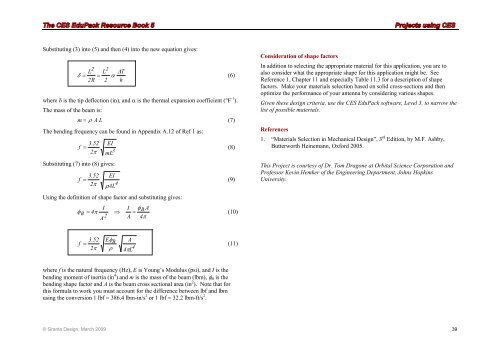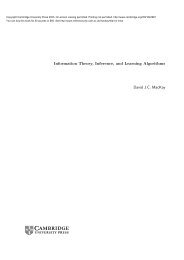Projects Using CES EduPack - MAELabs UCSD
Projects Using CES EduPack - MAELabs UCSD
Projects Using CES EduPack - MAELabs UCSD
You also want an ePaper? Increase the reach of your titles
YUMPU automatically turns print PDFs into web optimized ePapers that Google loves.
Substituting (3) into (5) and then (4) into the new equation gives:<br />
L<br />
2<br />
L<br />
2<br />
∆T<br />
δ = = α<br />
(6)<br />
2R<br />
2 h<br />
where δ is the tip deflection (in), and α is the thermal expansion coefficient (°F -1 ).<br />
The mass of the beam is:<br />
m = ρ A L<br />
(7)<br />
The bending frequency can be found in Appendix A.12 of Ref 1 as:<br />
3.<br />
52 EI<br />
f = (8)<br />
2π<br />
mL<br />
3<br />
Substituting (7) into (8) gives:<br />
3.<br />
52 EI<br />
f = (9)<br />
2π<br />
4<br />
ρAL<br />
<strong>Using</strong> the definition of shape factor and substituting gives:<br />
I I φ A<br />
φ 4π<br />
B<br />
B = ⇒ =<br />
(10)<br />
A<br />
2 A 4π<br />
3.<br />
52 EφB<br />
A<br />
f = (11)<br />
2π<br />
ρ 4πL<br />
4<br />
where f is the natural frequency (Hz), E is Young’s Modulus (psi), and I is the<br />
bending moment of inertia (in 4 ) and m is the mass of the beam (lbm), φB is the<br />
bending shape factor and A is the beam cross sectional area (in 2 ). Note that for<br />
this formula to work you must account for the difference between lbf and lbm<br />
using the conversion 1 lbf = 386.4 lbm-in/s 2 or 1 lbf = 32.2 lbm-ft/s 2 .<br />
Consideration of shape factors<br />
In addition to selecting the appropriate material for this application, you are to<br />
also consider what the appropriate shape for this application might be. See<br />
Reference 1, Chapter 11 and especially Table 11.3 for a description of shape<br />
factors. Make your materials selection based on solid cross-sections and then<br />
optimize the performance of your antenna by considering various shapes.<br />
Given these design criteria, use the <strong>CES</strong> <strong>EduPack</strong> software, Level 3, to narrow the<br />
list of possible materials.<br />
References<br />
1. “Materials Selection in Mechanical Design”, 3 rd Edition, by M.F. Ashby,<br />
Butterworth Heinemann, Oxford 2005.<br />
This Project is courtesy of Dr. Tom Dragone at Orbital Science Corporation and<br />
Professor Kevin Hemker of the Engineering Department, Johns Hopkins<br />
University.<br />
© Granta Design, March 2009 39
















